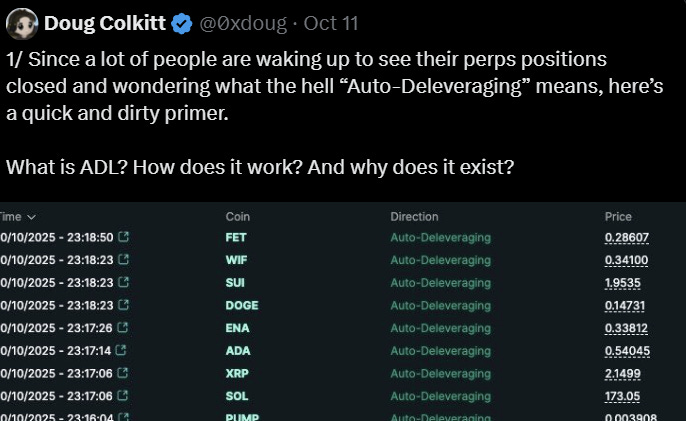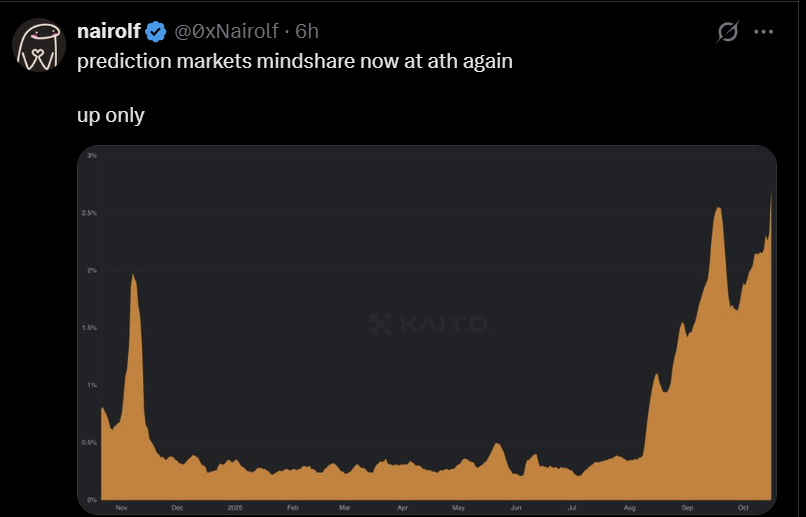🔎Biggest winners of the market crash
weekly valuable insights
Noon is a tokenless protocol that delivers market-leading stablecoin yields. Start earning with Noon today.
GM friends. Here’s what I’ll cover today:
🔎The biggest winners of the market crash
📊 Crypto chart of the week
🗞️ The latest DeFi news
🔎The biggest winners of the market crash
It’s been a historic week for crypto - and not in a good way.
As you all already know, a massive market crash happened on Oct. 11.
To put it into perspective, over $19 billion worth of crypto positions were liquidated on October 11. In comparison, the total value of the liquidations during the FTX crash was barely $1.6 billion.
WTF happened?
In short, the dip was caused by Trump’s announcement that he will impose 100% tariffs on China after China announced restrictions on rare earth mineral exports.
But rumors are also spreading that this was a coordinated attack or that some big players blew up and became forced sellers.
Regardless of what led to this, it was clearly a major stress test for DeFi.
In this issue, I thought it would be interesting to look at which crypto giants held strong during the market crash, and which ones didn’t. Let’s dive in 👇
First of all, I’ll talk about the ones who had a great performance.
Solana
I’m a huge fan of the Ethereum ecosystem.
But Ethereum L1 was completely unusable during the market crash.
L2s didn’t work well either, as the transaction fees on Arbitrum and Base skyrocketed to over $50 at the peak, making them too expensive for most people as well.
Meanwhile, Solana functioned flawlessly, and its median transaction fee hit $1 at its peak, which is more than reasonable given the scale of the dip.
All while Solana was processing more transactions than Ethereum and its L2s combined. In my opinion, this shows once again that Solana is here to stay.
Money markets
Major money markets such as AAVE, Euler, Kamino, and Fluid incurred zero debt and didn’t face any issues.
AAVE, for instance, processed $180M worth of collateral liquidations in just one hour without any issues, which is not an easy task at all.
Speaking about Fluid, one very interesting thing about it is that it does partial liquidations. While other money markets fully liquidate positions that drop below a certain loan-to-value level, some Fluid borrowers were only liquidated of 2% of their collateral during the dip.
You can imagine that losing 2% of your collateral is significantly less painful than losing 100%. Overall, it’s safe to say money markets have done a fantastic job last week and proved their resilience again.
Now, let’s move on to what didn’t work at all during the dip.
The biggest losers of the market crash are probably centralized exchanges.
Binance, Coinbase, and many other major CEXs experienced an outage, making it impossible to place or close any trades.
For spot investors, this might not necessarily be an issue. But many traders got liquidated in this way as they were unable to add margin or close their positions.
On Binance, the price of ATOM went down by 99.97% in just 10 minutes! Just in case you’re not familiar with it, ATOM is a billion-dollar asset, not a memecoin.
This makes me think there was some serious market manipulation.
To be frank, perpetual DEXs didn’t have a very good performance either. Hyperliquid didn’t go down (which is great!), but it forcefully closed the profitable short positions of a lot of traders during the dip due to its aggressive “Auto-Deleveraging” ADL feature.
It’s worth mentioning though that "Auto-Deleveraging” exists on CEXs too in order for them to prevent going bankrupt.
Lighter went down for 4 hours (a few hours after the crash). On the bright side, it closed fewer positions than Hyperliquid, as its ADL system is more trader-friendly, and I like that its team announced compensation for those affected by the downtime.
So each protocol has its own pros & cons.
But at the end of the day, one thing is clear:
DEXs are fully transparent; you can see everything that’s happening on them in real time on-chain, and they can’t freeze your funds.
Centralized exchanges are the exact opposite. We’ve seen what happened with FTX. And plenty of today’s CEXs do a lot of shady stuff in the background.
For now, it’s true that DEXs still need some massive UI improvements before they will be ready for mass adoption.
But DeFi winning in the end is inevitable.
Together with Noon
The Intelligent & Fair Yield-Generating Stablecoin
Most yield-bearing stablecoins suffer from the same problems:
Hidden risks, unsustainable emissions, or high hidden fees charged by insiders.
Noon is built to address exactly this.
Noon is a self-funded, transparent, and user-first protocol designed to deliver market-leading stablecoin yields while keeping fairness at the core.
Here’s what makes Noon different:
Intelligent allocation – The protocol dynamically deploys capital across multiple delta-neutral strategies, ensuring it maintains competitive yields.
Community-first – 65-80% of its future token supply will be distributed to users.
Fully transparency – Noon is the first ever stablecoin to offer live, real-time proof of solvency verified by a trusted third party.
Looping strategies – Users can maximize both yield and points by leveraging its tier-1 DeFi partners such as Euler, Pendle, Spectra and more.
The average 30-day yield of Noon’s sUSN yield-bearing stablecoin is 9%. And this doesn’t even include the points rewards that you get on top of that.
The sUSN APY has consistently outperformed the yield generated by other trending yield-bearing stablecoins such as sUSDe, USR, and deUSD.
The protocol is already live on Ethereum, zkSync, TAC, and Sophon, with more chain integrations coming soon.
Crypto chart of the week
Prediction markets’ mindshare is at all-time high
Crypto Meme😂
The latest developments in DeFi
Hyperliquid launched the HIP-3 upgrade, enabling anyone to launch their own perps market
Robinhood launched 400+ Stock Tokens via Arbitrum One
Hyperwave, a leading DeFi protocol on HyperEVM, has launched its public token sale, with 7% of the total $HWAVE supply available until October 20
INFINIT launched Strategies, enabling users to discover and execute complex DeFi strategies via one-click and integrated with Binance Wallet
Mantle Network’s institutional trading volume is up 112% in the last month, and its 7-day DEX trading volume hit a new ATH
MegaETH announced its upcoming ICO on the Sonar launchpad
Monad launched its airdrop claim portal
Neutrl, the first DeFi protocol to generate yield via OTC market strategies, went live
Ethena partnered with UR to enable using USDe for everyday spending
Alipay, the world’s largest fintech app, launched an Ethereum L2 called Jovay
Sonic announced it bought back $6 million worth of S tokens
Lighter surpassed $1 billion in TVL for the first time
Aerodrome introduced a programmatic buyback model for AERO
Paxos mistakenly minted $300 trillion worth of PayPal’s PYUSD stablecoin☠️
Strata, a dApp building structured yield products on Ethena, launched its mainnet
Chainlink has launched its first native, real-time oracle on MegaETH
Thailand implemented 0% capital gains tax on crypto
Kalshi raised $300 million in funding
Avantis announced a buyback mechanism for AVNT
Meteora released its MET token airdrop checker
That’s all for this week!
Until next time,
The DeFi Investor
Want to sponsor this newsletter?
Please send me a DM on Twitter (X). I have a sponsorship deck that I can send you.






